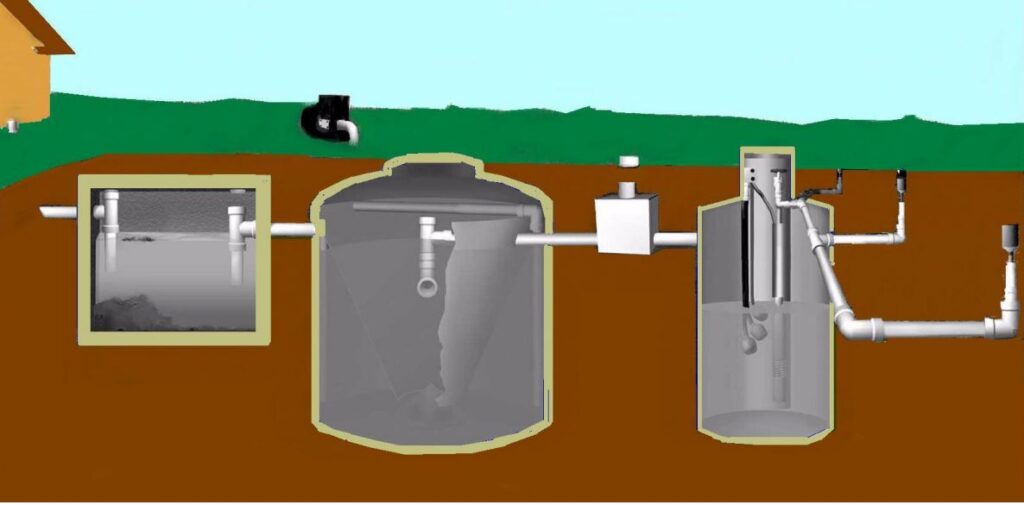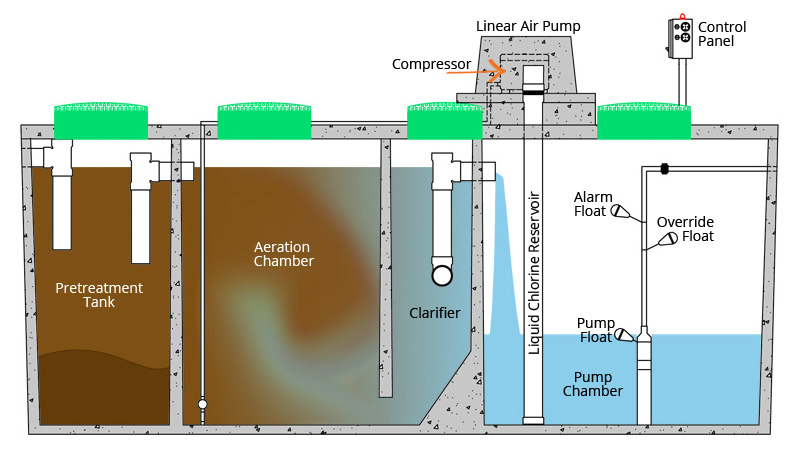In this article, you’ll learn about the components included in a residential aerobic septic system diagram. We’ll discuss the purpose and functions of each element, such as the septic tank, aerator, clarifier, and disinfection unit. Understanding the diagram can help you comprehend how the entire system works and ensure its proper maintenance. By the end, you’ll have a clear understanding of the residential aerobic septic system and how it functions to effectively treat wastewater.
Overview of Residential Aerobic Septic System
Residential aerobic septic systems are a modern alternative to traditional septic systems that utilize oxygen to breakdown and treat wastewater. These systems consist of several components that work together to effectively treat and dispose of household wastewater. In this article, we will explore the definition and importance of residential aerobic septic systems, as well as the various components that make up these systems.
Definition of Residential Aerobic Septic System
A residential aerobic septic system is a wastewater treatment system that utilizes oxygen to break down organic matter and remove harmful bacteria and contaminants from household wastewater. This system differs from traditional septic systems as it incorporates an aeration chamber, which promotes the growth of beneficial bacteria that digest the waste more efficiently.
Contrary to traditional septic systems that rely on anaerobic bacteria to break down waste, the aerobic septic system provides a more efficient and effective treatment process. The use of oxygen-rich aeration chambers allows for the decomposition of waste at a much faster rate, resulting in cleaner and safer wastewater.
Some of the benefits of using a residential aerobic septic system include:
- Higher treatment efficiency: The aerobic process employed by these systems ensures a more thorough breakdown of organic matter, resulting in cleaner and safer effluent.
- Reduced odors: The presence of oxygen helps to eliminate foul odors commonly associated with traditional septic systems.
- Less maintenance: The aerobic septic system requires less maintenance compared to traditional systems due to its higher treatment efficiency.
- Environmentally friendly: These systems help prevent water pollution and promote environmental sustainability by effectively treating wastewater before it is discharged into the environment.
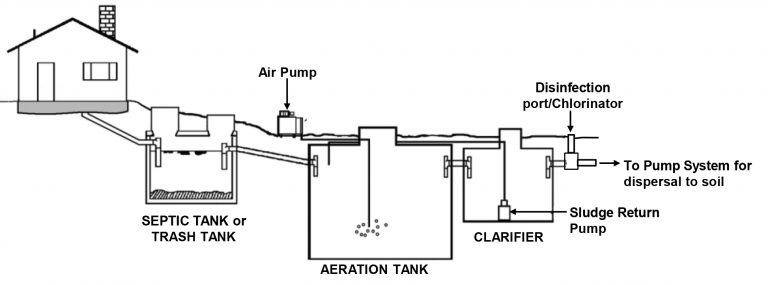
Importance of Residential Aerobic Septic System
Proper sanitation is paramount to ensuring the health and well-being of individuals and communities. Residential aerobic septic systems play a crucial role in maintaining proper sanitation by effectively treating and disposing of household wastewater.
By utilizing an aerobic treatment process, these septic systems can remove a higher percentage of harmful bacteria and contaminants from wastewater compared to traditional systems. This not only protects the health of individuals using the water supply but also prevents the proliferation of waterborne diseases in the surrounding environment.
Another significant importance of residential aerobic septic systems is their role in preventing water pollution. When wastewater is not adequately treated, it can contaminate groundwater and surface waters, leading to serious environmental and health concerns. The aerobic treatment process employed by these systems ensures that wastewater is treated to a level that minimizes its impact on the local water supply, protecting both human and aquatic life.
Moreover, residential aerobic septic systems promote environmental sustainability by effectively treating wastewater before it is discharged into the environment. By removing harmful bacteria and contaminants, these systems help preserve water quality and promote the overall health of ecosystems.
Components of Residential Aerobic Septic System
- Septic Tank
The septic tank is the first component in a residential aerobic septic system. It acts as a primary treatment unit that receives and holds the incoming wastewater. The septic tank allows for the separation of solids from liquids, enabling the anaerobic breakdown of organic matter.
The design and capacity of the septic tank are essential factors to consider during installation. The size and configuration of the tank should be based on the average water usage of the household to ensure sufficient treatment capacity.
- Aeration Chamber
The aeration chamber is the heart of the aerobic septic system, where the aerobic treatment process takes place. In this chamber, oxygen is introduced into the wastewater to promote the growth of aerobic bacteria that efficiently break down organic matter.
Aeration chambers are typically equipped with diffusers or air stones that release oxygen into the wastewater, creating an oxygen-rich environment. The presence of oxygen promotes the growth of beneficial bacteria, which digest the waste more thoroughly compared to anaerobic bacteria in traditional septic systems.
- Clarifier Tank
After the wastewater undergoes the aerobic treatment process in the aeration chamber, it is then transferred to the clarifier tank. The clarifier tank allows for the separation of solids from the liquid effluent. Solid particles settle at the bottom of the tank, while the clarified water rises to the top.
- Chlorination Unit
Once the wastewater is clarified, it flows into the chlorination unit. Chlorine is added to the effluent to disinfect and kill any remaining bacteria and pathogens that may pose a health risk. This final step ensures that the effluent is safe to be discharged into the environment.
- Disinfection Unit
In some residential aerobic septic systems, a separate disinfection unit may be included to provide additional treatment to the effluent. This unit may utilize ultraviolet (UV) light or other disinfection methods to further reduce the presence of harmful bacteria and pathogens.
- Effluent Pump
To transport the treated wastewater to the designated disposal area, an effluent pump is used. This pump pushes the effluent through distribution lines or spray heads to evenly distribute the treated wastewater.
- Distribution Lines
Distribution lines are responsible for dispersing the treated effluent across a designated disposal area, such as a drainfield or leach field. These lines are designed to evenly distribute the effluent over a large area, allowing for further treatment of the wastewater by the soil.
- Control Panel
A control panel is incorporated into the residential aerobic septic system to monitor and regulate the various components. The control panel is responsible for activating the aeration system, controlling the effluent pump, and overseeing the overall operation of the system.
- Alarm System
An alarm system is often included in residential aerobic septic systems to alert homeowners of any issues or malfunctions within the system. This ensures that prompt action can be taken to address any potential problems before they escalate.
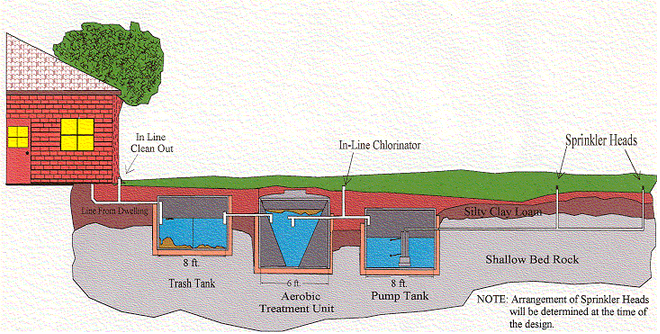
Septic Tank
The septic tank plays a crucial role in the residential aerobic septic system by receiving and holding the incoming wastewater. The primary function of the septic tank is to allow for the separation of solids from liquids. It acts as a sedimentation chamber, where solid particles settle at the bottom, and clarified effluent rises to the top.
The design and capacity of the septic tank are crucial factors in ensuring its effectiveness. The size and configuration of the tank should be based on the average water usage of the household to ensure sufficient treatment capacity. The typical septic tank has a capacity ranging from 1,000 to 1,500 gallons.
Aeration Chamber
The aeration chamber is one of the key components of the residential aerobic septic system. In this chamber, oxygen is introduced into the wastewater to promote aerobic bacteria growth and facilitate the breakdown of organic matter.
The aeration process involves the use of diffusers or air stones that release oxygen into the wastewater. The oxygen-rich environment promotes the growth of aerobic bacteria that digest the waste more efficiently and quickly compared to anaerobic bacteria in traditional septic systems.
The aerobic bacteria in the aeration chamber require a constant supply of oxygen to thrive. Therefore, a continuous flow of air is maintained in the chamber to ensure optimal conditions for aerobic digestion.
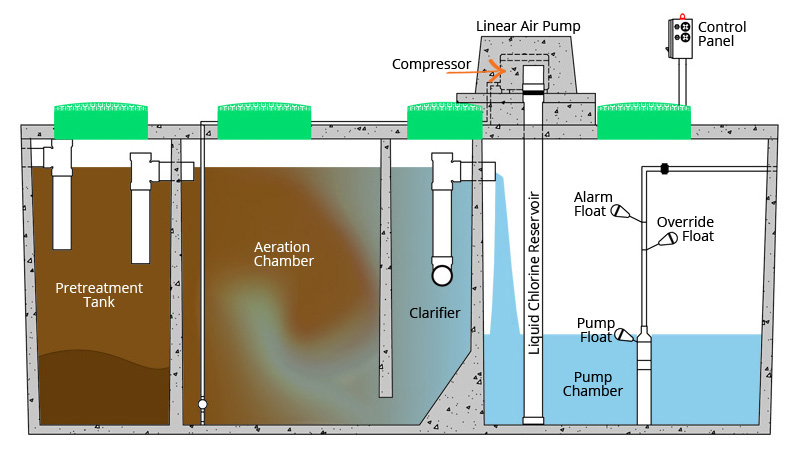
Clarifier Tank
After the wastewater undergoes the aerobic treatment process in the aeration chamber, it is then transferred to the clarifier tank. The clarifier tank is responsible for the separation of solids from the liquid effluent.
In the clarifier tank, solid particles settle at the bottom due to gravity, while the clarified wastewater rises to the top. The settled solids are periodically removed from the tank to prevent them from accumulating and affecting the efficiency of the system.
Chlorination Unit
The chlorination unit is an integral part of some residential aerobic septic systems. In this unit, chlorine is added to the effluent to disinfect and kill any remaining bacteria and pathogens.
The chlorination process ensures that the treated effluent is free from harmful bacteria and is safe for disposal or reuse. Chlorination effectively eliminates potential health risks associated with inadequately treated wastewater.
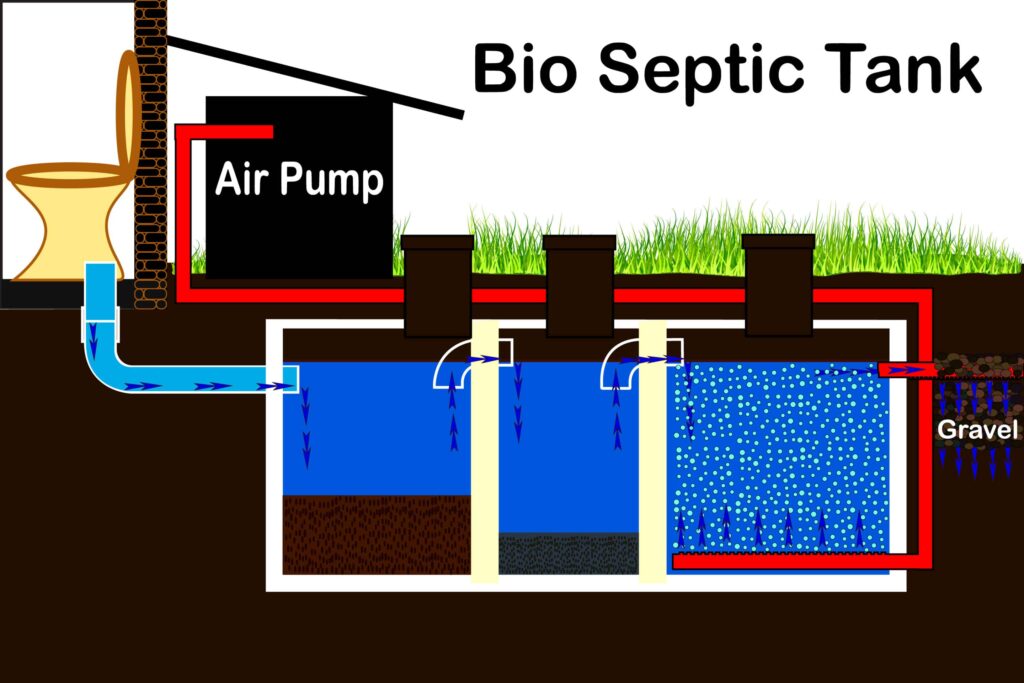
Disinfection Unit
In addition to the chlorination unit, some residential aerobic septic systems may include a disinfection unit for further treatment of the effluent. This unit may utilize ultraviolet (UV) light or other disinfection methods to further reduce the presence of harmful bacteria and pathogens in the effluent.
The disinfection unit provides an additional layer of protection by eliminating any remaining bacteria or pathogens that may have survived the aerobic treatment process. This ensures that the effluent is of the highest quality before it is discharged into the environment.
Conclusion
In conclusion, residential aerobic septic systems offer an efficient and effective method of treating and disposing of household wastewater. Through the use of oxygen-rich aeration chambers and various other components, these systems provide a higher level of treatment compared to traditional septic systems.
The components of a residential aerobic septic system, including the septic tank, aeration chamber, clarifier tank, chlorination unit, disinfection unit, effluent pump, spray heads, distribution lines, control panel, and alarm system, work together to ensure proper treatment and safe disposal of wastewater.
It is crucial to install and maintain a residential aerobic septic system properly to maximize its efficiency and preserve water quality. Regular maintenance, such as checking the system for any malfunctions or blockages, ensuring proper aeration, and adhering to recommended maintenance schedules, is essential for the system’s long-term performance.
Proper installation and maintenance of a residential aerobic septic system not only protect the health and well-being of individuals but also help prevent water pollution and promote environmental sustainability. By understanding the various components and their functions, homeowners can ensure that their septic system operates smoothly and effectively.
